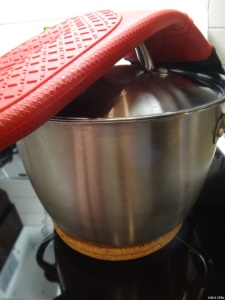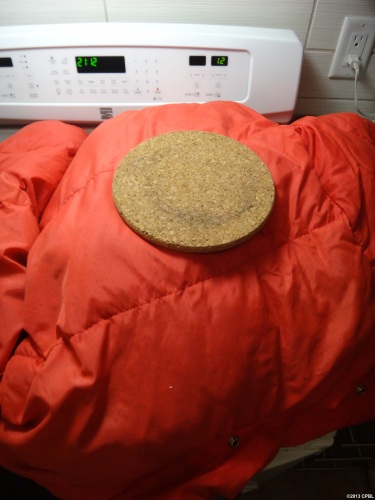This is an interlude from my normal blog themes. Just a little bit of physics tells you, I think, how we will cook in a future in which energy is electric and a bit more precious. It seems in North America “retained heat cooking” and induction cookers are both exotic, but they are less so in some other places.
First, my stove, which looks normal, is not so normal in these parts. It’s an induction stove, in which electric energy is transferred directly to the metal of a steel or iron pot through electromagnetic induction, rather than inefficient conduction (most electric stoves) or convection (gas stoves). This allows both for high power and high efficiency, has all the tuneability and responsiveness that would otherwise make gas attractive, is fueled by renewable electric power, and is surely the only sensible way to cook.
However, this post is not about how much I love my induction stove in general.
It’s about how ridiculous another aspect of cooking equipment is for most tasks: we cook with thin-walled pots which lose heat nearly as fast as you can put it in. It turns out that “heat” is not a magic substance which you must continually add to make something cook (i.e., much of cooking does not involve endothermic chemical reactions). Rather, it is a state variable (temperature) which for many purposes must merely be maintained for cooking to happen.
Consider the cooking of beans and beany soups, for which it is now de rigeur to buy an electric crock pot. Here’s my improvised version using just an induction stove.
Step 1: add beans and water to pot
Step 2: bring to boil (just)
With a 2.5kW induction stove, that takes just a few minutes even with a big pot.
Step 3: insulate bottom and top of pot
Step 4: add a vapour barrier to protect your fancier insulation
Step 5: Pile on the down / sleeping bags etc
Step 6: Leave overnight ….
Presto! Here’s the result next morning:
The beans stay hot, so the beans stay cooking. It’s that simple.
That’s all. Yummy beans ready to eat with a total of 6 minutes of power use.
One more thing… Now here’s where the induction stove comes in. For most purposes, there is nothing special about the boiling point for the cooking process, so that 90°C is about as good as 100°C (if you don’t need violent convection, like for keeping pasta from sticking to itself).
But if I want to keep it right near boiling, I can. If I take out one (or both) of the cork pads underneath the pot, I can actually leave the stove on (the lowest setting is sufficient, clearly!). The electromagnetic energy passes through the cork without losses (heating), and no heat is coming through the glass, so the only hot thing is the pot itself.
And it stays very close to the water temperature, which is no more than 100°C, a safe temperature for cotton and even nylon.
For cooking which needs more monitoring, our pots of the future could still be heavily insulated around their sides. Using modern electronic cooking technology, this would not pose any trouble such as fire risk.
“Safety second” liability clause: don’t really leave it on unattended for 8 hours. And if you do, take out both cork pads, so that the induction stove’s safety sensor can tell if the pot gets dry and hot.
And a reality check: none of this matters in the big-picture energy scene at the moment — we just need to stop our driving and flying and leaky buildings — but such “hot box” cooking is probably a part of our all-electrical future, and already very useful in less affluent societies.









Inspiring. Thanks.
great posts, especially for person like me who loves to Cook.